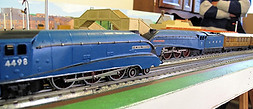





Gallery Section
Hornby O gauge is the larger scale (1:43) products either clockwork or electric. They were the first Horby trains initially produced from Meccano parts. The company soon moved to the easier dedicated tab and slot tinplate construction. This continued until the end of O gauge production. Models were enamel finished but later moved to tinprinting. The use of transfers replacing much of the hand lining in later models.

Hornby Dublo are the smaller scale (1:76) products first produced just before WW II The locomotives were mainly diecast. The rolling stock were tinplate, but were later produced by plastic injection moulding. The passenger rolling stock used tinprinted sides right to the end of production. The later super-detailed coaches had with plastic moulded roof, ends and under frame. As three rail was discontinued, metal gave way to plastic wheels on rolling stock.

In 1931 The MECCANO Ltd introduced diecast toys under the name Modelled Miniatures eventually taking the familiar name of Dinky Toys. They were to no particular scale but may of them were compatible with the O gauge system. These like the Hornby Train grew into a large range of models. With the introduction of Hornby Dublo a range of Dinky Dublo models was introduced in the 1950's to complement the Dublo System.

In 1901 the first patent for "Mechanics Made Easy" was lodged. Tin Boxes of nickel plated strips, steel axle rods, brass wheels, with nuts and bolts were marketed under this brand. The idea was initially slow to sell but Frank persisted.
In 1910 the name MECCANO was coined and the product became a household name. In 1927 the first coloured MECCANO sets were produced in the deep red and green. The sets have gone through many iterations since then but are still available now made by MECCANO of France.

Although Hornby was the most prolific producer of model railways, other companies both manufactured and imported model railways. Bassett-Lowke, Leeds Model Company & Milbro were three of the more popular UK brands.
They tended to be more accurate to prototype but were somewhat more expensive. Bassett-Lowke imported a lot of their product from Europe, but did contract with LMC to supply some of their range as did Milbro. Other brands producing cheaper trains included Brimtoy and Chad Valley.




Australian manufacturing was boosted by the lack of supply during and after the second world war. There were 3 main players Robilt, Ferris & Maurlyn and a number of lesser known brands including Scorpion & Cranko of New Zealand.



Initial toy production started in continental Europe under such iconic names as Marklin, Bing, Doll and later Fleischmann. Some of these firms had produced models for the British firms. However, after World War I relations were strained and local British production was encouraged. Consequently, these firms then produced mainly European outline models. America had its own indigenous production with Ives, Lionel and American Flyer.
© 2016 HRCAA Note the trademark Hornby and all associated publications are used by permission of Hornby PLC